Fiasco Italo-Brittanico
Part 1: Alfa's inverse Midas touch
Author
- Henri Greuter
Date
- February 16, 2009
Related articles
- March-Alfa Romeo 90CA - Fiasco Italo-Brittanico, by Henri Greuter
- Introduction
- Part 2: Indy teams keep on March-ing
- Part 3: The Indy project that became a blackmail project
- Part 4: Patrick Racing, a brief history up to 1989
- Part 5: 1989 - Alfa picking up the pieces
- Part 6: 1989 - Winning major prizes on the road to losing everything
- Part 7: 1989 - The first Alfa Romeo-powered CART racer
- Part 8: 1989 - A hopeful start for Alfa Romeo
- Part 9: Preparing for 1990
- Part 10: The 90CA in more detail
- Part 11: Exhaust solutions a 'waste' of effort?
- Part 12: 90CA on active duty - up to halfway into the month of May
- Part 13: 90CA on active duty - the early part of the second week of practice at Indianapolis
- Part 14: 90CA on active duty - wrestling through the second week of practice and qualifying
- Part 15: 90CA on active duty - about the Alfa Romeo V8 engine
- Part 16: 90CA on active duty - the last part of 'Indianapolis'
- Part 17: 90CA on active duty - after Indianapolis
- Part 18: The end of the road for March in CART and as a whole
- Part 19: The left-over hardware and where to find it
- Part 20: Final verdict on the March-Alfa Romeo 90CA
- Appendix I: Specifications
- Appendix II: Results and scores
- Appendix III: March-Alfa Romeo 90CA-related collectables and memorabilia
- March-Porsche 90P - The last oddball at the Indianapolis Motor Speedway, by Henri Greuter
Who?Bruno Giacomelli What?Alfa Romeo 179 Where?Monza When?L Italian GP (September 9, 1979) |
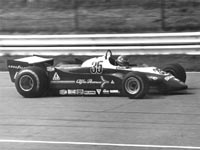 |
Why?
Before the first CART Alfa Romeo appeared on track a large number of events had taken place before which eventually led to the project becoming a reality. Many of these factors happened at the same time but independently from another. in this section, split into several parts, we will look at all these factors.
The pieces of the jigsaw (part 1)
Know the legend about King Midas? The man so obsessed with gold that when he was granted a wish he wished that everything he touched turn to gold? Legends say it eventually killed him because all food and drink he touched turned into gold.
Others say that what made him famous and successful was the fact that everything he undertook was carried out so well that he rarely failed to achieve his goals. Alfa Romeo managed to do exactly the opposite in its sports racing projects after the mid-seventies. Have a look at this:
1976: Alfa Romeo teamed up with Brabham in F1, using the flat-12 Alfa 3-litre sportscar engine. The engine could not be used as a stressed member, thus subframes were needed to install the engine within a chassis. Brabham discovered to their utter amazement that no single flat-12 was identical and they had to create different subframes for about each specific engine to be built into a BT45!
The engine was retired after three seasons with only two victories, both in 1978 and both of them in unusual circumstances. The first victory was for Niki Lauda with the controversial Brabhham BT46B 'fan car' at Anderstorp. The second one was the shortened Italian GP (restarted late in the afternoon after the accident of Ronnie Petterson) which Lauda won after the first two drivers at the finish (Andretti and Villeneuve) were penalized one minute for jumping the start. Alfa’s own car using the flat-12, test driven by Niki Lauda in 1978, was discarded.
Having mentioned the flat-12 sportscar engine, the sportscar using this engine (the 33/3) took several race wins, became World Champion in 1977 when no other team took part in the category, and yet they rarely appeared at Le Mans, by that time the only sportscar race of any value and importance.
1979: Ground effects were introduced to Formula 1, making V-type engines necessary to employ this technology. Alfa developed a V12, based on the flat-12 used by Brabham. Drivers Lauda and Piquet scored one retirement after another with this unreliable engine. A non-championship race in Italy was won by Lauda in what turned out to be the swansong for the Brabham-Alfa and a temporary swansong for Lauda. Meanwhile, Alfa decided on doing Formula 1 on their own after all, raced the forsaken flat-12 car once and debuted a V12-powered car at the Italian GP that year. Bernie Ecclestone knew enough: the Brabham-Alfa contract was discarded instantly.
1980: Only in the final races of the season did the Alfa F1 show its speed and competitiveness. The team, however, mourned the loss of driver Patrick Depailler, killed at Hockenheim in a test session. What was to be Alfa’s future was also shown: a turbocharged V8 to replace the V12. Alfa shocked every engineer when the engine was fitted with eight separate carburettors instead of fuel injection.
1981 seemed to promise a lot but nothing came of it. Mario Andretti started the season as one of the favourites but had a terrible final season in Formula 1. The 1982 season saw no sign of the turbo V8; a pole position at Long Beach was the highlight of the season. The turbo V8 finally arrived for the 1983 season (fuel-injected after all) but no victories or good results were achieved. During the 1983 season the discarded V12s were made available to the small Osella team.
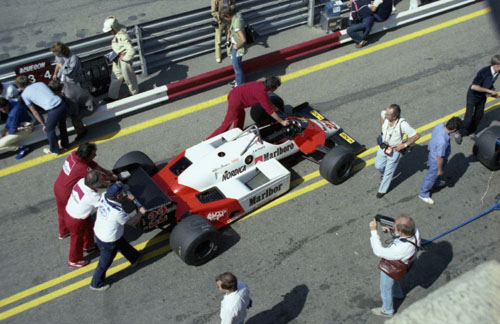
The 1983 Alfa Romeo F1 car, the 183T, here seen in the pit lane at Zandvoort. The first signs of the development of the Coca-Cola bottle shape sidepods (pioneered by McLaren) can be seen. (photo HG)
Things went from bad to worse for Alfa when Formula 1 became a fuel consumption formula from 1984 on and the thirsty Alfa V8 was no longer a serious option.

Euroracing fielded the Alfas from 1984 on. This is Riccardo Patrese on the front straight at Zandvoort during tyre test sessions held late July 1984. (photo HG)
Following two more years under the Euroracing banner, the factory team was disbanded after the 1985 season. The 1985 chassis 185T being so hopeless that the team gives up of it and drags up the 1984 cars from the mothballs to finish off the season and then being disbanded.
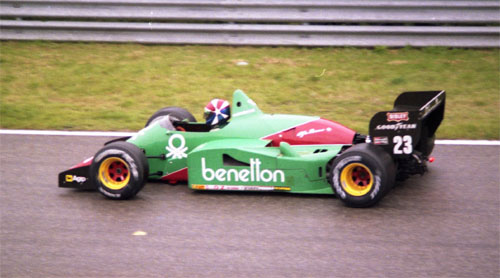
During the second half of the 1985 season Euroracing brought the 184T back into action again to replace the hopeless 185T. The 1985 version had the smaller rear-wing arrangement. The ear-like rear-wing extensions used the year before were banned from 1985 on. This is Eddie Cheever on the second qualifying day at Zandvoort. (photo HG)
The V8s were then used by backmarker team Osella but after a while they were only allowed to use the V8 as long as the Alfa name was removed from the cam covers… Osella kept the outdated V8s operational until the end of the F1 turbo era when the team lacked the funds to replace them with the slightly more modern Motori Moderni V6s.
Meanwhile, early in the eighties, Alfa Romeo had toyed with the Alfetta GT and Alfetta Turbo Delta in rallying. These weren't very big efforts but they were still doing something. The arrival of the 4WD Audi quattro in rallying caused any rival car without 4WD turn into a dead-end street. Nevertheless, privateer teams used the Alfetta GTV6 with quite some success at lower levels up until 1987. Especially on tarmac rallies the car was a serious competitor in Group A. After the tragedies of 1986, Group B was axed and the homologation rules for Group A cars were slightly changed, the GTV6 becoming one of the prime victims.
1986: Alfa Romeo became part of the FIAT group so from now on they were together with FIAT, Lancia and Ferrari. With Lancia in rallying and sportscars and Ferrari in F1 that left these arenas of racing forbidden territory to Alfa. Before being absorbed in the FIAT group Alfa had been working on something that was now giving problems: a turbocharged in-line four for Formula 1, ready for introduction in the 1987 season. But then it was announced that turbo engines were to be banned shortly! Nevertheless, Alfa teamed up with the French Ligier F1 team that replaced its Renault V6s with the Italian four-bangers. The straight-four Alfa featured two turbochargers. Every cylinder had two exhaust valves and the engine had eight exhaust pipes. Each turbo was fed by exhaust gasses from every cylinder. During the first test sessions with the engine driver Rene Arnoux came to Alfa’s rescue. His comments about the engine were so negative that it embarrassed both Ligier and Alfa Romeo. But it handed Alfa the perfect excuse to save money and cancel the engine instantly. Given the circumstances it offered the best option to avoid going head to head with new ’partner’ Ferrari in the same championship as well as avoiding the need to develop an engine which had, at best, only two years of active duty to go and was yet to be properly developed. So it became an unraced engine that went straight into the museum in 1987.
Another project Alfa had taken up was a risk as well. FIA had announced a new championship for so called ProCars. These were mid-engined chassis using 3.5-litre atmospheric engines but with coachwork resembling that of a production car. Alfa started development of a 3.5-litre V10 and Brabham built a chassis on which an Alfa Romeo 164-lookalike body was installed. The car was shown and demonstrated to the public at the 1987 Italian Grand Prix at Monza. It looked remarkably standard. It had no wide wheel arches, no massive front spoiler and a tiny rear wing. Seeing this remarkably normal looking car rushing down the straight at absurd speeds with the loud scream of a pure-bred racing engine was an unusual experience, nearly unreal.
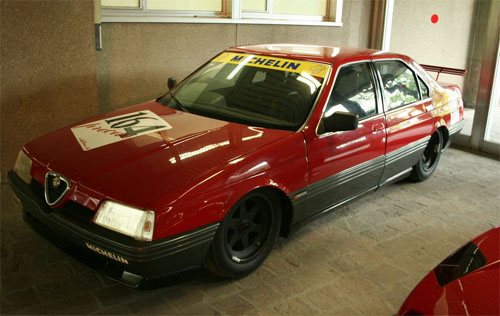
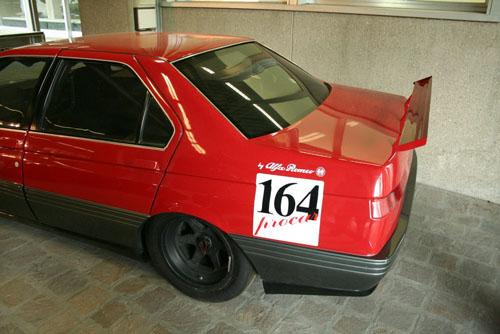
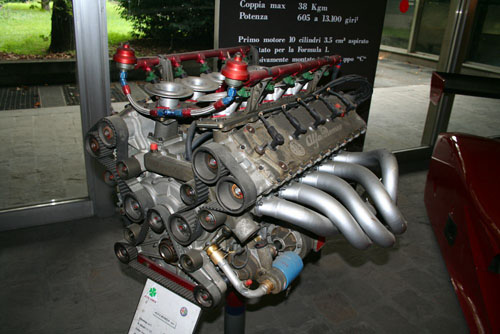

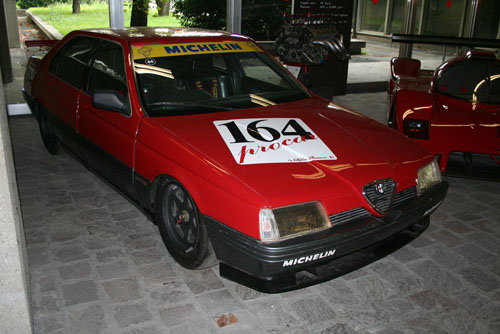
Several pictures of the peculiar 164 ProCar and its V10 engine. (photos by Arjan de Roos)

The ProCar with its engine cover off at the 1989 Amsterdam AutoRAI car exhibition. (photo by Louis Spaanderman)
ProCar was unreal. Nobody but Alfa Romeo developed a car for this formula. Not a single ProCar formula event was ever held and the Alfa Romeo V10 was the second unraced engine that went into the museum during 1987! And this time it brought along a car to be put next to it.
See what I mean with 'inverse Midas touch'?
